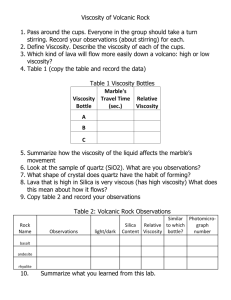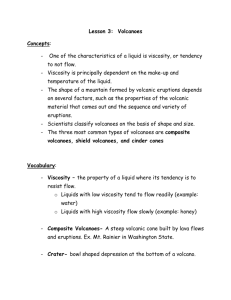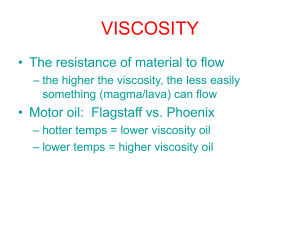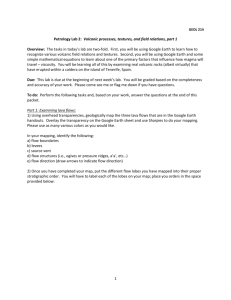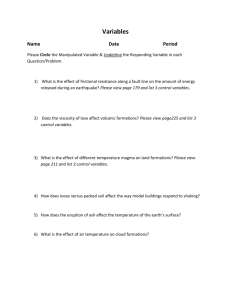Andesite Flow assignment
advertisement
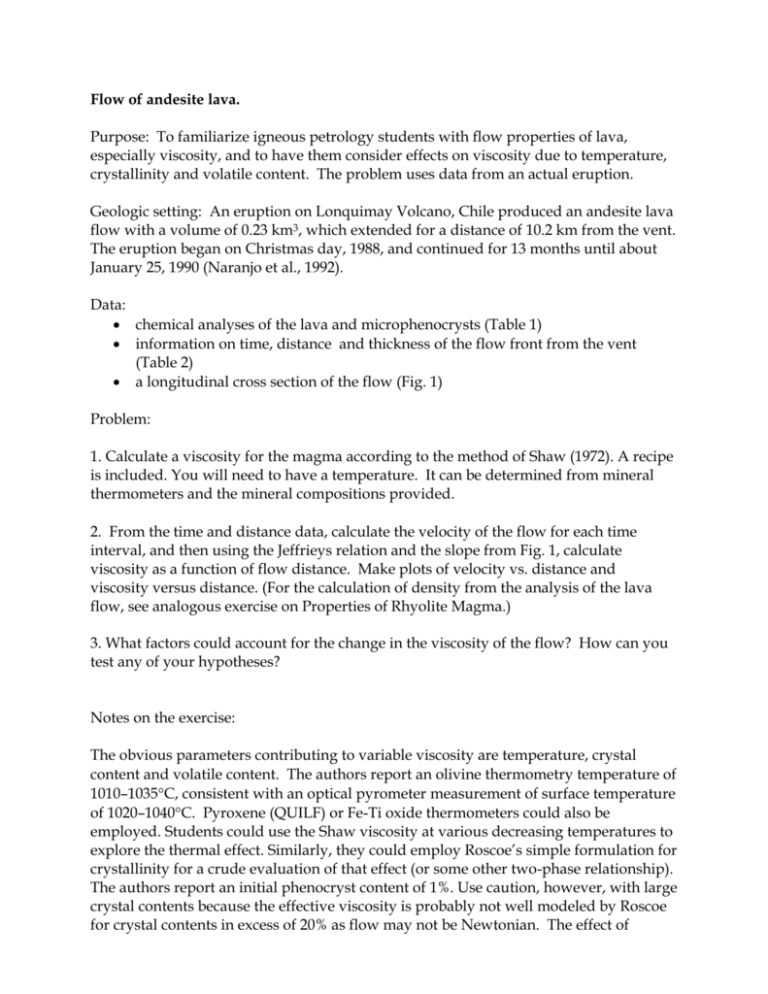
Flow of andesite lava. Purpose: To familiarize igneous petrology students with flow properties of lava, especially viscosity, and to have them consider effects on viscosity due to temperature, crystallinity and volatile content. The problem uses data from an actual eruption. Geologic setting: An eruption on Lonquimay Volcano, Chile produced an andesite lava flow with a volume of 0.23 km3, which extended for a distance of 10.2 km from the vent. The eruption began on Christmas day, 1988, and continued for 13 months until about January 25, 1990 (Naranjo et al., 1992). Data: chemical analyses of the lava and microphenocrysts (Table 1) information on time, distance and thickness of the flow front from the vent (Table 2) a longitudinal cross section of the flow (Fig. 1) Problem: 1. Calculate a viscosity for the magma according to the method of Shaw (1972). A recipe is included. You will need to have a temperature. It can be determined from mineral thermometers and the mineral compositions provided. 2. From the time and distance data, calculate the velocity of the flow for each time interval, and then using the Jeffrieys relation and the slope from Fig. 1, calculate viscosity as a function of flow distance. Make plots of velocity vs. distance and viscosity versus distance. (For the calculation of density from the analysis of the lava flow, see analogous exercise on Properties of Rhyolite Magma.) 3. What factors could account for the change in the viscosity of the flow? How can you test any of your hypotheses? Notes on the exercise: The obvious parameters contributing to variable viscosity are temperature, crystal content and volatile content. The authors report an olivine thermometry temperature of 1010–1035C, consistent with an optical pyrometer measurement of surface temperature of 1020–1040C. Pyroxene (QUILF) or Fe-Ti oxide thermometers could also be employed. Students could use the Shaw viscosity at various decreasing temperatures to explore the thermal effect. Similarly, they could employ Roscoe’s simple formulation for crystallinity for a crude evaluation of that effect (or some other two-phase relationship). The authors report an initial phenocryst content of 1%. Use caution, however, with large crystal contents because the effective viscosity is probably not well modeled by Roscoe for crystal contents in excess of 20% as flow may not be Newtonian. The effect of degassing can be examined by varying water contents in the Shaw calculation keeping in mind that although some degassing will occur, the initial volatile content upon eruption is most likely low to begin with. I have students construct their own spreadsheet for calculating viscosity. I include the recipe here. Also included is an operational spreadsheet. If they are constructing their own spreadsheet, it helps to give them a worked example to test their algorithm. A. Jeffreys equation (Jeffreys, 1925; Nichols, 1939) for flow down a slope: = ( g sin d2) / (3 v) where is viscosity, v is velocity, is density, is the slope and d is the flow thickness. B. Effective viscosity, * [after Roscoe] * = (1 – 1.61 )-2.5 where is the volume fraction of crystals. C. Additional files: 1. ViscCalc.doc: Recipe for calculation of viscosity according to Shaw (1972) 2. ViscShaw.xls: Excel spreadsheet for viscosity calculation. References: Jeffreys, H., 1925. The flow of water in an inclined channel of rectangular section. Phil. Mag., 49, 793–807. Moreno, H., and Gardeweg, M. C., 1989. La erupcion riciente en el complejo volcanica Lonquimay (Dicembre 1988), Andes del Sur. Revisita Geologica de Chile, 16, 93–117. Naranjo, J.A., Sparks, R. S. J., Stasiuk, M. V., Moreno, H., and Ablay, G. J., 1992, Morphological, structural and textural variations in the 1988–1990 andesite lava of Lonquimay Volcano, Chile. Geological Magazine, 129, 657–678. Shaw, H. R., (1972), “Viscosities of magmatic silicate liquids: an empirical method of prediction.” American Journal of Science, 272, 870-893. Barbara Nash University of Utah 2003


